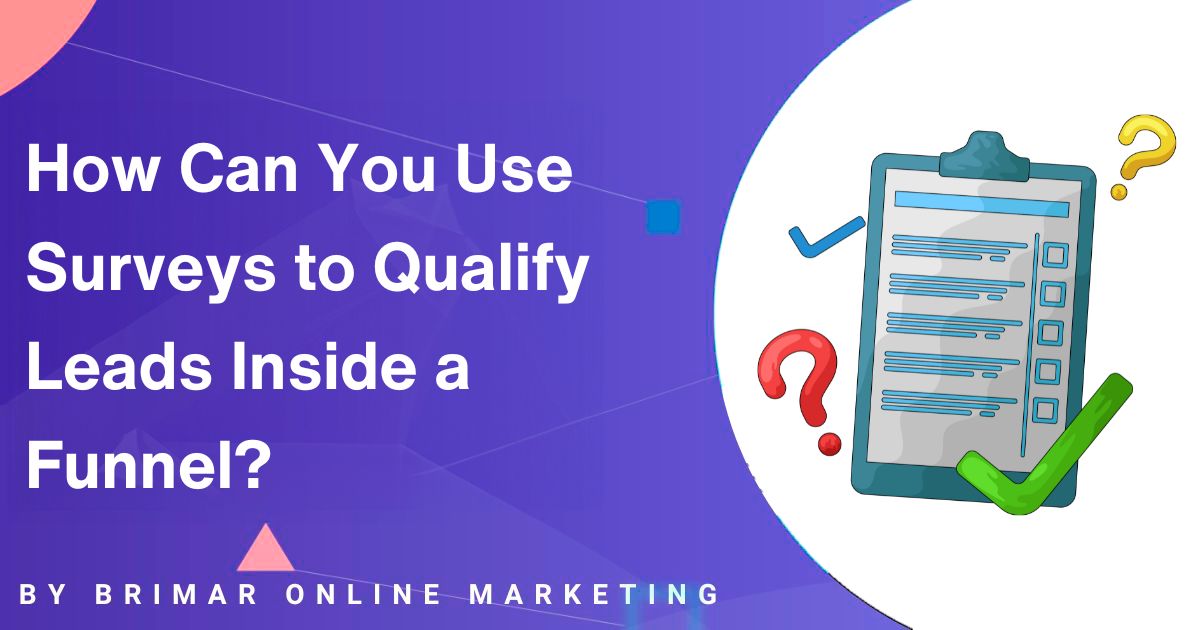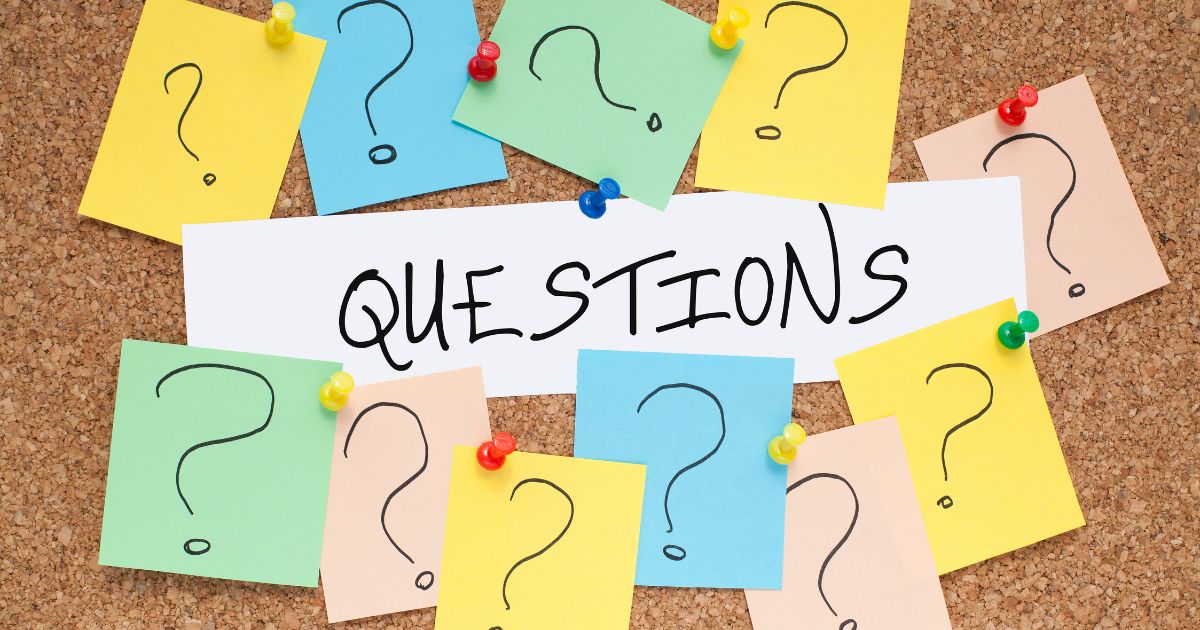
Not every lead that enters your funnel is worth your sales team’s time.
Some are just curious, others are not ready to buy, and only a fraction are genuinely qualified to become customers.
That’s why lead qualification isn’t just a nice-to-have; it’s essential for keeping your sales pipeline healthy and focused on real opportunities.
Surveys are one of the most overlooked yet powerful tools for this.
When used correctly, they help marketing teams and sales teams separate the right leads from the wrong ones.
Instead of chasing every click or email address, you can quickly identify potential customers who match your ideal customer profile and have the decision-making authority to move forward.
A well-structured survey funnel does more than collect data.
It improves conversion rates by guiding people through a smoother experience, captures valuable information about your target audience, and gives you clarity on who is a good fit.
The result?
A more efficient sales funnel, better user experience, and stronger marketing strategy built on facts, not guesses.
Why Use Surveys for Lead Qualification?
A lead generation survey is exactly what it sounds like: a set of survey questions designed to gather insights from prospective customers as they move through your funnel.
Instead of relying only on landing pages or cold emails to guess at interest, surveys give you direct answers that help with the lead qualification process.
Online surveys make it simple to collect basic information: name, email address, company size, and other contact information that every marketing funnel needs.
However, the real value lies in the details hidden within survey responses.
With the right questions, you’ll uncover customer needs, pain points, and even the biggest challenge that stands in the way of your potential buyers.
This mix of data makes surveys stand out.
On one side, you get quantitative results like point values or numerical scores that can be tied to lead scoring systems.
On the other hand, you collect qualitative insights through open-ended questions and follow-up questions that reveal what people are really thinking.
Together, this combination helps marketing teams and sales teams move beyond surface-level data and zero in on high-quality leads who are more likely to take the next step in the sales cycle.
Need a Sales Funnel that Converts?
Struggling to turn clicks into customers?
A high-converting sales funnel could be the missing link. We’ll help you build a simple, straightforward, and effective funnel that guides your visitors step-by-step, so they take action, not just browse.
Building a Survey Funnel That Works
A good survey funnel isn’t just a form slapped on a page; it’s a carefully designed path that guides prospective customers while giving your marketing team the insights it needs.
Think of it as a conversation, not a questionnaire.
The first step is integrating surveys into your existing funnel elements.
A landing page can host the survey, paired with a lead magnet that offers something valuable in exchange, like a guide, checklist, or even a free trial.
Once someone fills out the survey, their details are added directly to your email list, giving you the opportunity to continue the conversation through follow-up emails.
This smooth integration makes surveys feel like a natural step in the customer journey rather than an interruption.
Interactive surveys take this a step further.
Instead of long, boring forms, you create short, engaging interactions where each answer leads to the next question.
This improves response rates dramatically because people feel like they’re moving through a personalized experience.
When surveys are engaging, you’ll collect more data and get a clearer picture of what your potential customers want.
Now, here’s where lead scoring comes in.
Assigning point values to answers helps you prioritize who deserves your sales team’s attention first.
For example:
- A larger company size may score higher than a small startup if you’re targeting enterprise clients.
- Someone with decision-making authority is more valuable than someone who can’t sign off on a purchase.
- Prospects who clearly outline specific needs that match your solution get more points.
- A budget and timeline that fits within your offer moves them closer to being a hot lead.
By ranking survey responses with point values, your team can separate the right leads from unqualified ones, making the sales pipeline more efficient.
Finally, don’t overlook built-in analytics.
Tracking survey performance over time shows you which questions get skipped, which options drive higher conversions, and where people drop off.
Use this data to refine your lead generation process.
Over time, small adjustments, like rewording a question or changing the order, go a long way in increasing both the quality of leads and the accuracy of your qualification criteria.
Crafting the Right Survey Questions

The power of a survey funnel hinges on asking the right questions.
The wrong ones can frustrate people or give you meaningless data, while the right questions unlock insights that transform your marketing strategy.
For market research and lead qualification, every question should serve a clear purpose.
If it doesn’t help your marketing team or sales team understand your target audience better, it probably doesn’t belong in the survey.
Here are some essentials to include:
- Basic information: This covers name, email, and company size. It gives you the foundation to follow up with the right people and segment your email list properly.
- Specific needs: Ask about the biggest challenge they’re facing right now and what solution they’re looking for. This not only identifies pain points but also shows if your offer is a good fit.
- Decision-making process: Questions about budget, authority, and timeline help you see if someone is ready to take the next step or if they’ll need more nurturing.
- Customer experience expectations: Understanding what kind of user experience they value—fast support, simple onboarding, advanced features—guides both your sales conversation and product development.
When it comes to format, use a mix of open-ended and multiple-choice questions.
Open-ended questions give you qualitative data, letting people describe their pain points in their own words.
These responses are gold for uncovering insights that your sales copy, blog posts, and marketing campaigns can use.
Multiple-choice, on the other hand, makes it easy to assign point values for lead scoring and compare responses across your entire target market.
The balance between the two is key.
Too many open-ended questions, and you’ll lose response rates.
Too many multiple-choice questions, and you’ll miss out on the nuance of customer needs.
When done right, your survey questions won’t just qualify leads; they’ll also strengthen your understanding of your ideal customer profile and improve the entire lead generation process.
How Surveys Fit Into the Sales Funnel
Surveys don’t work if they sit on the sidelines.
To get results, they need to be placed at the right point in the sales funnel, when prospective customers are most open to sharing their thoughts.
Put one too early, and you’ll scare people off with too many questions before trust is built.
Place it too late, and you’ve missed the chance to learn what matters before they make a decision.
Think of surveys as conversation starters.
They fit naturally into different conversion stages of your marketing funnel: after someone engages with a blog post, while they’re scrolling through your social media platforms, or even as part of a cold email that invites them to share what they’re struggling with.
Each touchpoint provides an opportunity to gather valuable information without making the process feel like an interrogation.
Once you have their attention, surveys act as a guide.
Instead of leaving people to guess their next step, you can use their answers to send them in the right direction.
Someone might finish a survey and get an invitation to start a free trial.
Another person may be better suited for a quick phone call with your sales team.
Others might receive a series of follow-up emails filled with educational content that addresses their pain points.
The real magic of a survey funnel is segmentation.
Every response helps you sort potential customers into clear groups.
A hot lead is someone with an immediate need, the budget to solve it, and decision-making authority.
Potential leads may show interest but need more time, nurturing, or proof that your solution fits their specific needs.
And then there are unqualified leads, people who aren’t a good fit right now.
Instead of wasting marketing efforts on everyone equally, your sales team gets to focus energy where it counts.
By weaving surveys into your sales funnel this way, you’re not just collecting data.
You’re creating a smoother path for prospective customers while giving your marketing teams and sales pipeline a steady flow of the right leads at the right time.
Best Practices for Using Surveys

Surveys can do far more than collect answers.
When handled the right way, they become one of the most powerful tools for identifying high-quality leads, guiding your sales team, and shaping smarter marketing strategies.
Here are some best practices to make sure your survey funnel delivers the best results.
1. Maximize responses by keeping it simple
People won’t complete long, complicated surveys.
The best way to boost response rates is to make them short, clear, and engaging.
Ask only the key questions you need to qualify potential leads, such as company size, decision-making authority, and specific needs.
Interactive surveys tend to perform well because they feel more like a conversation than a form.
2. Run A/B tests to see what resonates
What you think is the right question may not always be the one that gets the most useful answers.
That’s why A/B testing your survey questions is essential.
Try different versions of the same question and compare response rates.
For example, asking “What’s your biggest challenge?” might yield more honest insights than “What keeps you from reaching your goals?”
Small changes like wording, order, or even layout can improve both completion rates and conversion rates.
3. Refine your buyer persona with survey data
Your buyer persona should never be static.
Survey responses give you real-time, valuable information about your target market.
Use them to update your ideal customer profile, whether it’s refining age ranges, job roles, company size, or the specific pain points that matter most.
The more accurate your persona, the easier it is to create marketing campaigns that speak directly to the right people.
4. Feed results into your sales and marketing systems
A lead survey isn’t the end of the process; it’s the beginning of a stronger sales pipeline.
Feed the results into your CRM so your sales team can prioritize hot leads, tailor follow-up emails, and schedule phone calls with potential clients who are a good fit.
On the marketing side, survey insights can drive better lead nurturing sequences, ensuring prospective customers receive educational content that speaks to their stage in the sales cycle.
This alignment between marketing teams and sales teams goes a long way in driving business growth.
5. Use survey insights for product development and customer journey improvements
Surveys often reveal trends that go beyond the lead qualification process.
When potential buyers repeatedly highlight the same pain points, that’s a clear signal for product development.
A software company, for instance, may discover that new leads struggle with integrations.
Acting on that feedback can lead to a new feature that wins over prospective customers and strengthens loyalty among existing ones.
Beyond products, surveys help improve the customer journey by removing friction and ensuring every stage, from landing pages to follow-up emails, matches the needs of your target audience.
Surveys aren’t just about gathering data.
They’re about creating conversations that uncover the right leads, refine your marketing strategy, and ultimately improve the customer experience at every stage of the funnel.
Final Thoughts

Surveys are one of the best ways to qualify potential clients at the right time because they cut through the noise.
Instead of guessing who’s serious and who’s just browsing, a well-structured survey gives you clear signals about who’s ready to move forward.
When you ask the right questions, you uncover pain points, decision-making authority, and the specific needs that separate a hot lead from an unqualified one.
That saves your sales team time and helps your marketing efforts reach the right people instead of spreading thin.
Used correctly, surveys go a long way in finding customers who are not just interested but truly a good fit.
They let you filter prospective customers with simple criteria like company size, biggest challenge, or timeline, so you know exactly who belongs in your sales pipeline.
This means your marketing teams aren’t chasing dead ends, and your sales team spends more time talking to high-quality leads that have a chance of becoming loyal customers.
The best way to start is simple.
Launch a lead generation survey, gather responses, and refine it as you go.
With built-in analytics, you can track response rates, test different survey questions, and optimize your qualification criteria until you’re consistently pulling in the right leads.
Small tweaks make a big difference, and every adjustment gets you closer to the best results.
If your goal is business growth, now is the right time to add surveys into your marketing strategy.
Start small, measure what works, and keep improving.
The payoff is a smoother lead qualification process, a healthier sales cycle, and a sales team that closes more deals with high-quality leads.
When you use surveys, you’re not just generating leads, you’re building a stronger, smarter path to long-term customers.
Our Digital Marketing Services Have Helped Our Clients Increase Their Revenue!
“I highly recommend Brimar if your looking to grow your online business. You will be satisfied with the high level of expertise and high quality of services. It has helped my business grow by leaps and bounds.”
CEO
